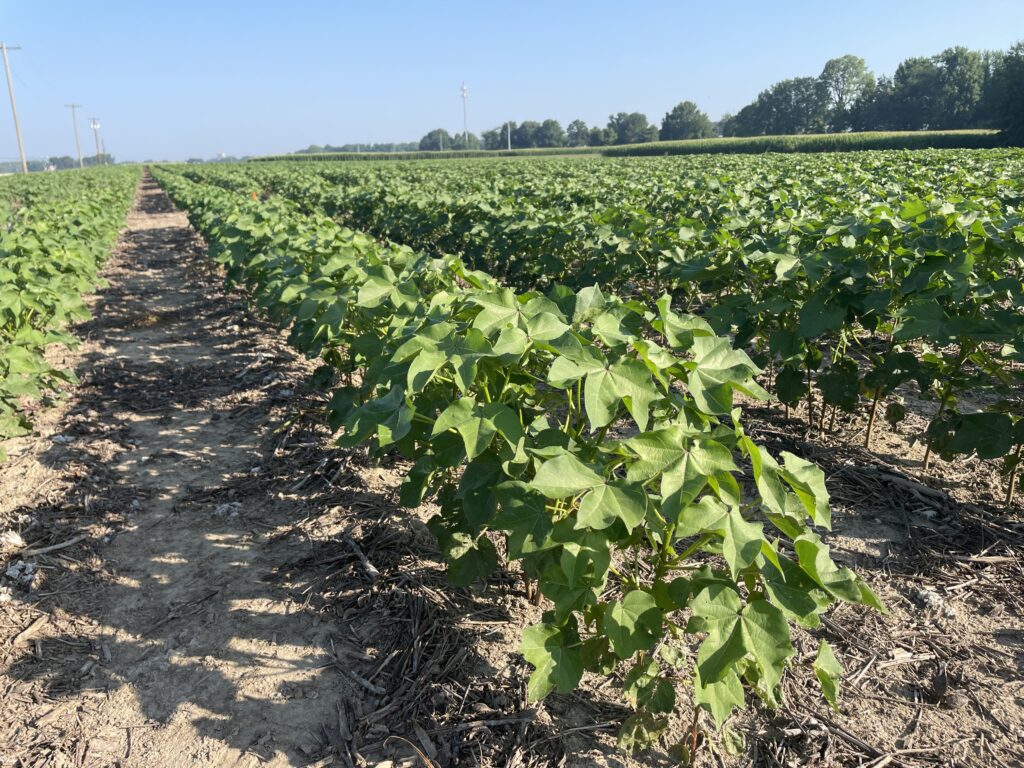
Our earliest planted acres have turned the corner and most of our later planted acres are right behind them. I expect this crop to take off with the rain forecast for next week. In this blog, I provide a few thoughts on the crop as we move into July.
June Temperatures
The challenges we faced planting the second half of our crop broke at the end of May to a relatively dry and mild June. I’ve had several express concern over the mild temperatures in June and lack of ‘hot’ temperatures. I’m not at all concerned- on the contrary, I’m actually very pleased- I couldn’t paint up a better June for cotton. Optimal max/min temperatures for cotton growth are often considered to be 86F and 55F, respectively. We don’t necessarily need temperatures warmer than that during any stage of cotton growth. What we must have are temperatures at or above that range through the boll fill period in the fall. The perception of cotton requiring heat comes from the long season requirement, not necessarily from a requirement for temperatures to break 100F. Again, we can easily tolerate the temperatures we have forecast for this week, but we don’t have to have them to push our crop into the next growth stage. The lower levels of humidity which generally come with cooler temperatures have also been a big plus. The transpirative engine of the cotton plant runs extremely well in conditions like what we’ve experienced through June.
June Rainfall (or lack thereof)
Many with the option to irrigate have been tempted to put water out to ‘jump start’ this crop. Most entered June with adequate soil moisture in the profile- I’ve yet to walk cotton in Tennessee this year that I felt needed pre-bloom irrigation. I am a firm believer that dry conditions early in a cotton plant’s life help balance reproductive growth with vegetative growth. Our dry June has been perfect for driving the taproot deep into the profile and preventing excessive vegetative growth early. My one concern with our dry June is the potential lack of incorporating rainfall to move our fertilizer into the effective rooting zone. I received calls as late as last week concerning sidedress applications of N. These applications need to be made prior to the end of this week, in my opinion, so we can take advantage of the rainfall chances through much of next week.
Decisions to make at the end of June through the first week of July
More than once I’ve left a short, puny looking crop for a long July 4th weekend and come back to a burgeoning, robust crop only days later. Our earliest planted cotton is about to make that transition, especially if we receive the rainfall forecast for next week- and our late planted cotton is only days behind. Banking on a forecast is risky but I will be applying low rates of PGRs to my earliest planted cotton by the end of this week to get ahead of what I expect will be a big jump. My first shot will be 6 oz of a 4.2% product- roughly 0.6 ounces per node. On strong ground planted to aggressive varieties, my first application would be closer to an ounce per node. The MidSouth Cotton Specialists’ Working Group is currently updating the PGR guide published last year with new varieties and I’ll post that updated guide as soon as it is available. For now, you can find the 2022 document here: https://news.utcrops.com/wp-content/uploads/2022/06/2022_PGR_Guide.pdf
Plant bugs have been moving into cotton a little earlier this year and retention has slid on some acres. Dr. Sebe Brown has been sending excellent updates out through the REMIND text message app- I would definitely recommend subscribing to that to get updates that I know you will find very helpful. Dr. Brown made great points with a message last week, including emphasizing the importance of maintaining 80% square retention prior to bloom and holding plant bug numbers below 8 per 100 sweeps during the first two weeks of square. Keeping retention above 80% and plant bugs below 8% has been challenging on some acres. On acres where retention has slid, I’m running Diamond earlier than normal to help control immatures and better protect young fruit from immatures. As always, keep in mind that you will need to add another product to Diamond to provide control of adults. Finally, don’t forget that while ThryvOn varieties provide some control of immature plant bugs, adult plant bugs can still knock squares off ThryvOn varieties and the MidSouth Entomologists have not changed the plant bug thresholds for ThryvOn varieties.

